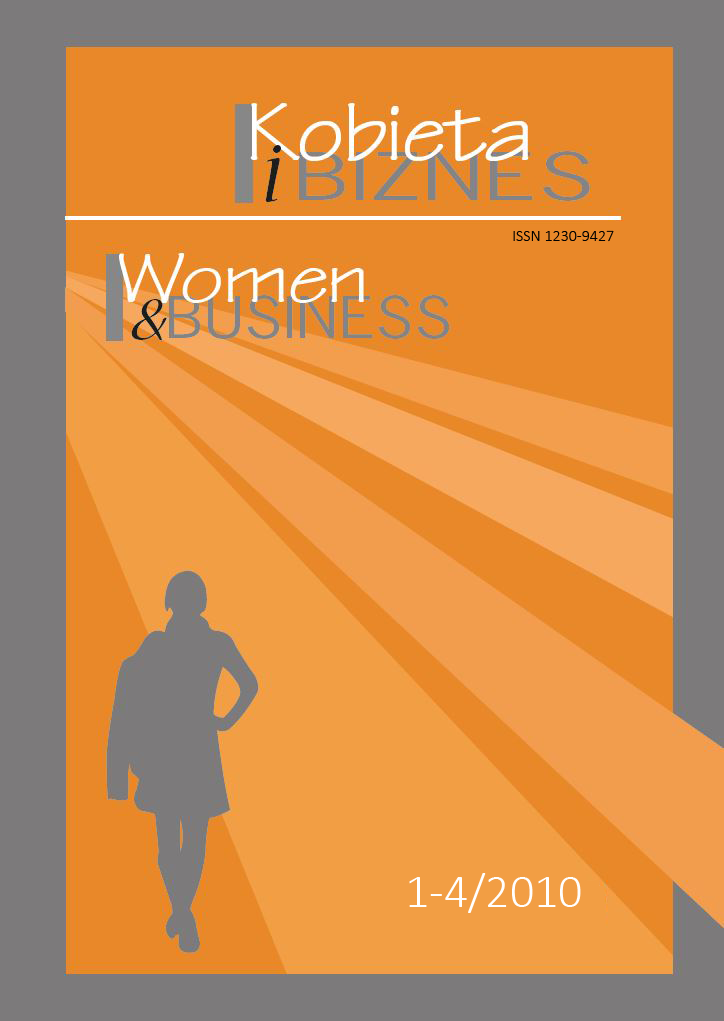Women in stock market companies versus company profitability
Main Article Content
Abstract
The share of women among the total number of managers in Poland is one of the highest in the European Union. The surveys carried out on the initiative of the Warsaw Stock Exchange in 2009 and 2010 indicated that in capital market companies and stock market companies, the share of women in the executive suite of all levels exceeds the country's average. The conducted surveys confi rm the regularity that the higher the steps of the executive ladder are the lower shares constitute women - on the top executive positions men decidedly dominate, also in those companies where the feminization rate of their human resources is relatively high. Joint-venture companies distinguishes implementation of the solutions promoting women to the executive positions, but mainly on the intermediate level, despite the fact that the employed by them women usually have tertiary education. These companies seem to be introducing western practices to the Polish business reality, as they more often present the belief that employing women and ensuring equal chances for their promotion to the executive positions, is not only a manifestation of obedience of the anti-discrimination law, but it also generates benefi ts for the company - staff diversity facilitates higher effectiveness. The Stock Exchange that undergone an evident evolution in the area of equalising chances of women and promoting them to the executive suite, including the top management level positively stands out against the background of the surveyed companies. It provides an example of good practice in this fi eld. The WSE Board comprises equal numbers of women and men. In the special resolution of 19 May 2010, the WSE recommended to all public companies adoption of solutions targeted at ensuring equal shares of women and men on the top executive levels, as it is profi table for the company's development. The conducted surveys - which were precursory in Poland - examining the situation in public companies lead to conclusion that there are still too few of them that are oriented towards the intentional benefi ting from the diversity of women's and men's talents. Particularly, the largest companies and companies from the industry and construction sector do not appreciate advantages of diversity and to a lesser extent make efforts aimed at employment of women or promoting them to the top executive positions. The companies implementing programmes targeted at equalising chances of women, such as special training including mentoring and coaching, planning professional career, positive discrimination. Few companies may be commended for having a female or male specialist for equal treatment whose task comprises monitoring the situation and reacting to any manifestation of discrimination based on gender or any other socio-demographic characteristics of the employed. Among the gender leaders, i.e. firms that declared implementation of between four and seven "women-friendly" solutions are the Bank BPH SA, Auxilium (the Expert Auditors Consulting Company), ATON-HT - waste utilization services, Mediatel SA - telecommunication services, Elektrobudowa SA - service and production of electric power equipment, KOGENERACJA SA - Wroclaw network heat and electricity, ARCUS SA - IT company. Polish public companies lack the approach characterising with purposeful increasing the number of women in the Boards and Supervisory Boards - following, e.g., the example of the "Fortune 500" largest American companies, or the Norwegian experience where quotas were adopted in business. Whereas, the initiated for the fi rst time in Poland analysis on the company profi tability depending on the share of women on the top executive level allows a hypothetical conclusion that the companies where this share comprises 30% or more the profi tability of the company is higher, at the same time these fi rms slightly better cope with crisis. The obtained data should be considered as a forerunner of oncoming tendencies and as an indication to further studies.
Article Details
Authors retain copyright and grant the journal right of first publication with the work simultaneously licensed under a Creative Commons Attribution License that allows others to share the work with an acknowledgement of the work's authorship and initial publication in this journal. All authors agree for publishing their email adresses, affiliations and short bio statements with their articles during the submission process.
Author agrees to share his work under CC-BY-NC license.
References
2. Adler D., Women in the Executive Suite Correlate to High Profi ts, 2001, www.equalpay.nu/docs/en/adler_web.pdf.
3. Labour Force Survey in Poland. IV quarter 2009, CSO , Warszawa 2010.
4. Catalyst Census of Women Board Directors of the Fortune 500, Catalyst 2007, www.catalyst.org.
5. Lisowska E., Kobiecy styl zarządzania [Female style of management], Helion, Gliwice 2009.
6. Piękniejsza strona rynku NewConnect [The prettier side of the market], "Puls Biznesu", 13.01.2009.
7. Good Practice Guide - Equal Opportunities Company, Gender Index, EQUAL, UNDP, Warsaw 2007.
8. The Business Case for Diversity. Good Practices in the Workplace, the European Commission 2005.

